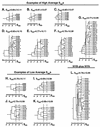Hospital specificity, region specificity, and fluconazole resistance of Candida albicans bloodstream isolates
- PMID: 9620370
- PMCID: PMC104870
- DOI: 10.1128/JCM.36.6.1518-1529.1998
Hospital specificity, region specificity, and fluconazole resistance of Candida albicans bloodstream isolates
Abstract
In a survey of bloodstream infection (BSI) isolates across the continental United States, 162 Candida albicans isolates were fingerprinted with the species-specific probe Ca3 and the patterns were analyzed for relatedness with a computer-assisted system. The results demonstrate that particular BSI strains are more highly concentrated in particular geographic locales and that established BSI strains are endemic in some, but not all, hospitals in the study and undergo microevolution in hospital settings. The results, however, indicate no close genetic relationship among fluconazole-resistant BSI isolates in the collection, either from the same geographic locale or the same hospital. This study represents the first of three fingerprinting studies designed to analyze the origin, genetic relatedness, and drug resistance of Candida isolates responsible for BSI.
Figures






References
-
- Abi-Said D, Anaissie E, Uzun O, Raad I, Pinzcowski H, Vartivarian S. The epidemiology of hematogenous candidiasis caused by different Candida species. Clin Infect Dis. 1997;24:1122–1128. - PubMed
-
- Backeljau T, De Bruyn L, De Wolf H, Jordaens K, Van Dongen S, Winnepenninckx B. Multiple UPGMA and neighbor-joining trees and the performance of some computer packages. Mol Biol Evol. 1996;13:309–313.
-
- Banerjee S, Emori T, Culver D, Gaynes R, Jarvis W, Horan T, Edwards J, Tolson J, Henderson T, Martone W. Secular trends in nosocomial primary bloodstream infections in the United States, 1980–1989. National Nosocomial Infections Surveillance System. Am J Med. 1991;91:86S–89S. - PubMed
Publication types
MeSH terms
Substances
Grants and funding
LinkOut - more resources
Full Text Sources
Medical
Miscellaneous

